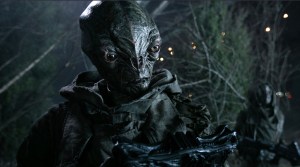The world of horror films was dominated by slashers in the ’80s, with these formulas and narratives growing tiresome by the time the ’90s rolled around. In 1992, director Bernard Rose aimed to reinvent audiences expectations of the subgenre with Candyman, inspired by the Clive Barker short story “The Forbidden.” Much like this original adaptation, writer/director Nia DaCosta hoped to revive the mythology of the source material while also circumventing audience expectations with her Candyman, and while she does manage to find fresh perspectives from both slasher-film and cultural angles, the culmination of the narrative doesn’t entirely stick the landing that the dark and disturbing storyline set up for its finale.
Videos by ComicBook.com
In hopes of finding new inspirations for his artwork, painter Anthony (Yahya Abdul Mateen II) visits Cabrini-Green, which isn’t just a former housing project that ejected its Black residents to gentrify the neighborhood, it was also the home of a series of grisly murders, some of which were attributed to a “Candyman.” This urban legend becomes an obsession with Anthony, as he aims to uncover the truth behind the legends, only for violent occurrences to surround him as his art embodies much darker subjects.
Filmmaker Jordan Peele has rightly earned acclaim with his films Get Out and Us and the ways in which he manifests cultural horrors with narrative terror, and while this praise is well-earned, he’s far from the first genre filmmaker to venture into these waters. Even the original Candyman found ways to embrace those tensions to aid the horror of its premise, due in large part to the “villain” being killed just for the color of his skin. Despite that film’s accomplishments, it figuratively crawled so DaCosta’s Candyman could walk.
When this new take on Candyman was announced, horror fans were excited to learn that Peele and frequent collaborator Win Rosenfeld served as writers and producers, as DaCosta’s previous efforts might not have immediately alerted audiences to the type of horror film she would deliver. Luckily, the opening minutes of DaCosta’s film turn all expectations on their heads in a number of ways, thanks to a clever homage to the opening moments of the original film. While that experience started with an overhead shot of the city of Chicago, tracking a car on a highway from high above, DaCosta delivers hypnotic and disorienting images of the city’s iconic skyscrapers surrounded by fog, but done so through an inverted lens. Rather than scraping the sky, these buildings plumb the depths of the unknown, hinting at the upcoming darkness that lurks underneath the entire city. This is just one of many ways in which DaCosta delivers entirely unexpected visuals, with one of the most chilling visuals being a brutal death that is witnessed through floor-to-ceiling windows from hundreds of yards away. The filmmaker puts her own stamp on the horror genre that feels as though she’s paving her own path instead of drawing solely from the genre’s past.
Late in the second act, Colman Domingo’s character plainly delivers the line to Anthony, “They love what we make, but not us,” which largely feels like the film’s thesis. Whether it be the ways in which the sense of community was established in Cabrini-Green, the paintings that original “Candyman” Daniel Robitaille created, or Anthony’s work, Black culture will always be coveted and consumed, all while the creators are ignored or even punished. This also speaks to American culture at large, whether it be the music, the fashion, or even slang that is stolen and repurposed by others, which includes the accomplishments of Black filmmakers (a fact proven time and time again by the lack of films coming from people of color).
Cultural allegories aside and from a straightforward horror standpoint, DaCosta (who also wrote the script) deftly threads the needle of delivering a reboot, a spiritual sequel, and a genuine continuation of the events that came before it in the franchise. There are countless creepy sequences in which characters are tempted to recreate the iconic repetition of saying “Candyman” five times, using a number of different surfaces and angles to deliver frights that exist only in reflection. Anthony’s mental and physical deterioration is easily the most grotesque and cringe-worthy component of the experience, which will surely draw comparisons to David Cronenberg’s The Fly, with the advances in special effects makeup in the decades since that remake arguably crafting an even more stomach-churning experience.
While much of the film is able to deliver on complex and layered cultural and deliberate horrors, where it stumbles is in its third act. After setting up these various promising avenues to pay off, that potential ultimately feels squandered in ways that feel like studio mandates. DaCosta’s pacing and ways she weaves back and forth between the film’s various themes all feel effortless, but in the last 15 minutes, everything is wrapped up in ways that feel forced to hit a specific run time and not entirely earned, featuring characters making unexpected and drastic decisions that cause the entire experience to falter. These setbacks surely don’t take away from the experiences that led up to it, but it does send audiences out on a whimper instead of a shout. Even with this overall underwhelming ending, DaCosta does manage to squeeze in one final horrifying sequence that is one of the film’s more distressing scenes, both for standard horror fare and with its message about abuse of authority.
The original Candyman didn’t entirely earn the same notoriety of the slashers that came before it, despite Tony Todd’s performance earning him and the film legions of fans, with its first sequel being a disappointment and third entry in 1999 heading straight to video. For decades, the franchise and its mythology has been a wealth of untapped potential, with DaCosta and her Candyman finally elevating the figure to his full and horrifying glory, proving how it’s not always the legend itself but the one telling the stories that determines how to strike fear into the hearts of audiences.
Rating: 4 out of 5
Candyman hits theaters on August 27th.








